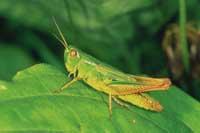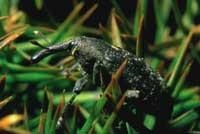Struggle of poor farmers

In her small maizal, Emerencia Ngwa has carefully taken a long, brown insect from a plant. "These pierce the plants," he says desperately. "There are many in our fields," he adds. This insect, called Coleoptera, lives on the ground, but from a moment goes up to the plant and begins to pierce the stem. The plant remains dwarf and the harvest is scarce. The main enemy of farmers who sow corn like the Ngwa is this hungry stems hilator, which often feels too late. To prove it, Ngwa has broken a plant that seems healthy and a drill has also appeared.
The scarce harvest of maize, millet or sorghum could become a disaster for entire families in various territories of Cameroon. You might think they could use pesticides, but instead Ngwa and other farmers in Ndop, in the northwestern province of Cameroon, burn rice shells. These extend into sown land a few days before the monsoon season, so that the rains dragged by the monsoons separate the basic components from the ashes and kill the drill from the ashes.
In the neighboring village, Andrew Kule is drying tobacco leaves. But he does not work tobacco, but vegetables, and prepares a mixture that protects from pests the tomato and eggplant plants he has now. The tobacco leaf is soaked one night and hot pepper is added, to darken the liquid. "The mixture is very hard, the plants are sprayed and for 24 hours almost all the insects are dead," says Kule with a little pride.
Like Kule and Ngwa, the lands of thousands of farmers in Africa and any developing country are battlegrounds for fighting daily pests. According to estimates by the UN Food and Agriculture Organization, more than 30% of the land planted in developing countries is destroyed by diseases and pests. They can even lose crops once collected.
However, instead of using pesticides, many poor farmers are created locally and use methods of pest control and storage of the stored crop. The reasons are several. On the one hand, pesticides are often inaccessible in distant territories. On the other hand, even if they are accessible, they can be excessively expensive. Finally, many farmers now know the health and environmental risks of pesticide overuse.
These local solutions are not limited to food planting or pests, but to the daily activity of farmers and the struggle to preserve their harvest. For example, farmers in distant territories have difficulty keeping the milk of the day until they reach the nearest trade or market. Boiled milk has a maximum duration of 48 hours, which is not enough. But there are the Fulanis, the nomadic cattle ranchers. These offer dairy farmers the knowledge accumulated through their traditions. According to Ma`u Dannire's fulanis, all milk producers should add the fern stem called babaaho when the milk is boiling, "the milk would last seven days from four to seven days without pain."
According to Sara Ngum, from the village of Njimbi, they have always suffered the plagues after harvesting. "My problem is gurgurgurgurgurus," he says.

The easiest way to get rid of gurio is by applying layers of eucalyptus leaves in the corn to dry in the sun. Eucalyptus oil will perform the rest of the tasks.
In the version developed by his neighbor Florence Fru, the corn dries on a kitchen roof, usually bamboo. He burns the cypress leaves and the plant called nachaachor (both known insecticides) in the kitchen with its closed doors. The smoke from the leaves will come out between the bamboo from the ceiling and kill the gurus.
Nachaachora, alubiada, rice leaf powder, hot pepper,... are just some of the techniques used and remembered by the peasants of Cameroon. According to experts from the non-governmental organization Hiefer Project International (HPI), these techniques are more than 400.
According to Joseph Toyang of the HPI, all they are doing is collecting information and trying to organize it. In addition, as an alternative to pesticides, self-employment and the use of indigenous knowledge in exploitation techniques is being encouraged. In his opinion, the success of the programme depends on the participation, trust and collaboration of farmers.
Toyang believes that indigenous wisdom can contribute much to the general development of territories such as Cameroon, where more than 80% of the working population is linked to agriculture (second activity in the national economy after oil). On the other hand, like the other developing territories, Cameroon's small possessions have absolute leadership in the sector, because massive plantations (most export crops) are below 10%.
According to FAO, some hazardous pesticides, prohibited or strictly limited in industrialized countries, remain exported to developing countries. The United Nations Environment Programme ensures that thousands of people are poisoned each year as a result of hazardous pesticides. Small farmers often cannot access these chemicals.
In addition, the global pesticide market continues to grow; according to FAO estimates, a profit of $30 billion was obtained in 1996. Western European companies are the largest producers of chemicals and pesticides in the world, while the fastest markets grow in Latin America and Asia. According to FAO, more and more pesticides are being used in export plantations in Africa. According to Toyang, indigenous methods are not only safer, they are in many cases the only alternative that poor peasants have with small agricultural plantations.

However, there are some aspects to mention in relation to these methods. Several experts are concerned that many of the plants that indigenous people use as a result of deforestation or abusive use are in danger of extinction and the PIE has enabled conservation gardens for their cultivation.
It is also necessary to identify with its scientific name the plants used by the locals, such as wild ferns, in order to increase the accessibility to knowledge and that these methods go through the screening of the scientific study and offer greater credibility. In any case, Emergency Ngwa warns that if we "regulate too much" with concrete scientific formulas, confusion would occur and move away from farmers.
According to experts, this requires a good measurement of work. For example, a general dosing list of indigenous pest control recipes can be of great help, but it is very difficult to do so. For many farmers the measurements are as accurate as saying a handful of peppers mixed with a little tobacco.
Farmers have also been warned that the tobacco/pepper mixture is toxic and can cause food poisoning, so they have been explained that before marketing their vegetables they should clean them properly. Setting the dosage should help moderate use of recipes.





